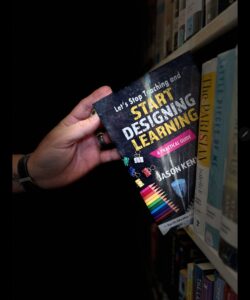Differentiation has long been characterized by an analogy that paints a daunting, almost impossible picture for educators: A single doctor stands in front of 30 patients, all with different ailments, and is expected to treat each one. It’s an analogy that resonates with many because it accurately reflects the overwhelming nature of trying to meet the diverse needs of a classroom full of learners. But while this analogy hits home, it also sets us up for failure. The metaphor of the overworked doctor with too many patients implies that differentiation is impossible—an unattainable ideal.
What if, instead of seeing ourselves as doctors battling an endless wave of unique ailments, we saw ourselves as coaches leading a team of players? A coach doesn’t treat their players like patients who need fixing or “curing.” Instead, they work with individuals, recognizing their strengths and weaknesses, guiding them toward growth, and ultimately fostering a sense of teamwork and accomplishment. It’s time to rethink the way we talk about differentiation.
The Doctor’s Dilemma: Why This Analogy Fails
At first glance, the analogy of a doctor faced with a room full of patients seems to make perfect sense for describing differentiation in the classroom. Each student is unique, just as each patient has their own symptoms and needs. The teacher, like the doctor, must diagnose these needs and offer tailored treatment. But this perspective is inherently flawed because it assumes that students are passive recipients of knowledge, much like patients waiting to be treated. That maybe the less effective and outdated view of what “teaching” is, but it certainly is not what learning should look like in the classroom.
The danger of this analogy is that it makes differentiation seem insurmountable. Doctors rely on extensive diagnostics and highly specialized treatments to address individual patients’ needs, but a teacher cannot reasonably diagnose and deliver 30 individualized treatments in a 45-minute class period. This line of thinking leads educators to feel overwhelmed and, worse yet, paralyzed by the weight of the task. But what if we shift the analogy? Instead of treating students as sick patients in need of intervention, let’s view them as capable players on a team, each with the potential to grow and improve under the right guidance.
From Patients to Players: The Coach’s Perspective
Now imagine a coach, not a doctor. A coach doesn’t see their players as people who need to be fixed or cured. Rather, they view them as individuals with unique abilities and room for growth. Each player might be at a different level of skill or experience, but the coach’s job is to bring out the best in everyone by leveraging their strengths and addressing their areas for improvement. The team works together, and the coach creates a playbook designed to meet various needs while working toward a common goal, the goal of learning.
This perspective more accurately reflects what differentiation should look like in the classroom. Teachers, like coaches, are not expected to “cure” their learners but to provide them with opportunities to develop their strengths, overcome challenges, and grow into well-rounded learners. Just as a coach recognizes that not all players will be star quarterbacks, a teacher understands that not all kids will excel in the same subjects or at the same pace. Differentiation doesn’t mean creating 30 different lesson plans—it means guiding learners through a shared experience while acknowledging and responding to their individual needs through the use of supports, scaffolds and feedback.
Designing the Playbook: How Teachers Can Differentiate Like Coaches
So how do teachers design the “playbook” for their classroom? Like a coach, it begins with recognizing that differentiation is not about managing chaos or creating dozens of individualized plans. Instead, it’s about creating opportunities where all students can engage with the material at their own level. Coaches craft drills and practices that are challenging yet achievable for each player, and teachers can do the same with their lesson designs.
Task design is key. Instead of thinking in terms of what students must “do” to show they’ve completed an assignment, we need to think about what they will produce that shows learning has occurred. Differentiation happens when we design tasks that allow learners to demonstrate understanding in various ways—whether that’s through collaboration, problem-solving, or hands-on activities. Differentiation also happens when we design tools for learners to use when they need to in order to have an equitable access to the learning. We don’t need to hold learners’ hands through every moment of instruction, just as coaches don’t run every play themselves. We provide guidance, tools, and the structure for students to take ownership of their learning. And in this way, we become less like the doctor diagnosing and treating ailments, and more like the coach, motivating and guiding players to excel on the field of learning.
The analogy of the doctor in a room full of patients is powerful, but it’s also limiting. It paints teachers into a corner, making differentiation seem overwhelming and impossible. But when we change the perspective to that of a coach guiding a team, the idea of differentiation becomes not only more feasible but also more inspiring. As educators, we’re not here to treat ailments or fix broken students. We’re here to guide, coach, and support our learners as they grow, develop, and work together toward a common goal. By embracing this shift, we not only reframe the challenge of differentiation but also empower ourselves to lead classrooms where every student, like every player on a team, has the opportunity to succeed.


